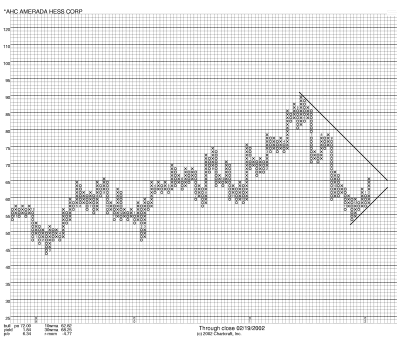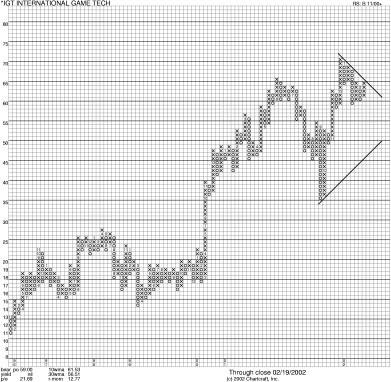Introduction: Sell high, Buy low?
Many years ago, I was teaching a group of brokers from Oppenheimer at the New School in New York, and was asked, "Are point and figure charts are always bullish at the top and bearish at the bottom?" I answered "No, most investors are often deceived into thinking that stocks making new highs are always good and stocks making new lows are always bad; but for the disciplined p&f trader there are some good chart signals that are bearish at the highs." In this article, we are going investigate one of three of these bearish top signals: The Broadening Top.You can look at the other 2 Signals in the articles The Buying Climax and The Bull Trap in the Point & Figure College section of the Investors Intelligence ’University’.
The Broadening Top
Buying Climaxes are often the first sign of a major top, and this action is often followed by a broadening top formation, a high pole and finally by the break of the up trend line.1. Example of a Broadening Top: Amerada Hess (AHC)

The stock took three signals to finally reverse the uptrend:
a) In Sept 2001, the stock gave a p&f sell at $68. The late, great Earl Blumenthal used to say that the first sell signal in a bull market is really a buy signal and this is also a very overlooked strategy.
b) AHC then rallied to give a triple top breakout at $73, ($5 higher than the sell). The stock then advanced to a Buying Climax high at $88 in April. This high was one box below the important Bullish Resistance Line, a Line that had previously been tested three times. This was selling signal number two in the uptrend.
c) We moved up to another buy at $89 that was followed by a Buying Climax at $90 and also one box below the Bullish Resistance Line.
Now, we have the pattern of a Top at $86, a low at $83, a higher top at $88, a lower low at $81 and when it makes another higher top at $89 , this is a broadening top formation which very often is the final top.
Most people don’t even notice this formation and in many P&F manuals it is considered to be bullish, but it is not. This is especially true when it comes at the top of an advance. In this case, it also set up sell signal number three, and this is often the most important sell in the up trend.
It is also an Elliot Wave indication with an up move, a down move, a second up move, a second down move and finally the third up move to a top. Sell signal number three is often the real signal, as it turned out to be in the case of AHC
While this action was going on, we also noted the stock had excessive insider selling.
As the stock broke below down to $80, the company announced a takeover bid for Triton Energy. The stock then broke its up trend line at $77 and began a down trend.
2. Example of a Broadening Top : International Game Technology (IGT) 
IGT has been a great stock most of 2000 and 2001.
In April 1998, we noted a shift to the buy side by insiders with the stock at $18. As is usual with insider action (insiders are often a year ahead of the herd) , the stock did little until March 1999, when with the stock still at $18, the strong advance began.
A down move from $49 to $43 resulted in the first sell in the uptrend Sell signal number two saw the stock fall from $57 to $46.
After that the stock moved to its all time high at $66 in June and this third sell was the big one as the stock fell all the way to $36.
It then reversed up after 19 boxes in a row straight down and this up move culminated to the Buying Climax high at $66.
Obviously, the sellers at the previous peak at $66 knew what they were doing with the stock falling to $36 in three months.
Currently, we have a High Pole Top above 67.5.
IGT insiders (who were right at the bottom) are showing no buyers and 22 sellers!
Conclusion: pay particular attention to stocks making climaxes and extended top formations in the region of previous tops.
